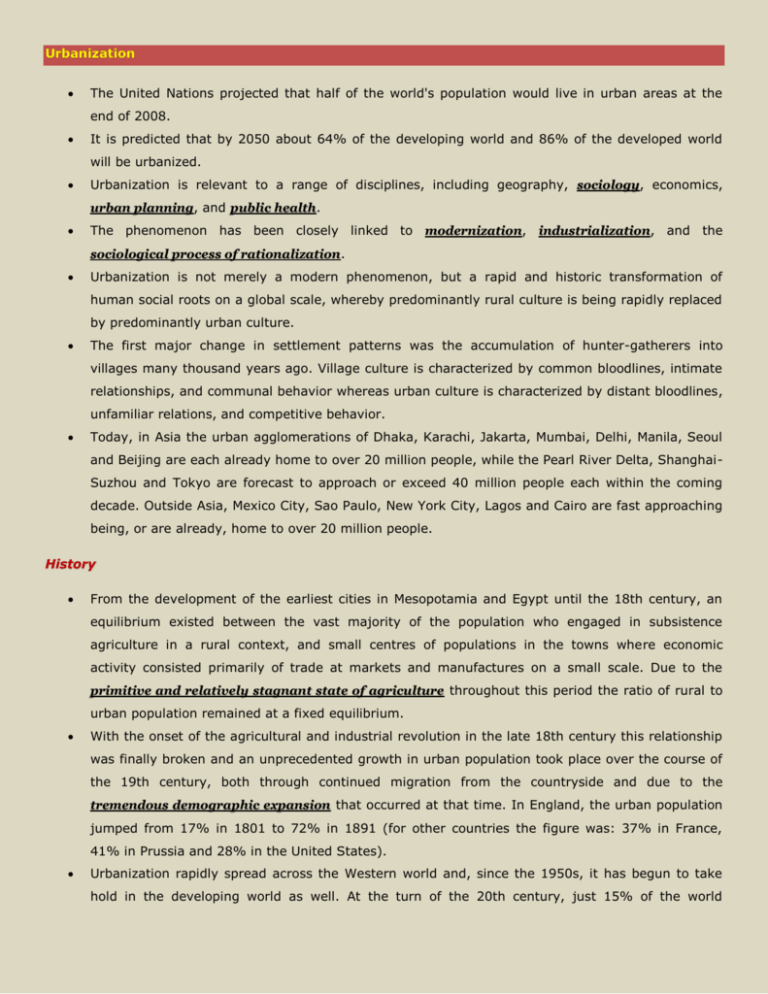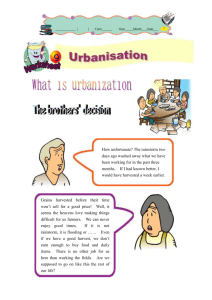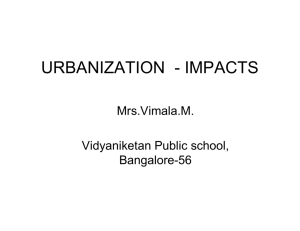Urbanization. GS1
advertisement

Urbanization The United Nations projected that half of the world's population would live in urban areas at the end of 2008. It is predicted that by 2050 about 64% of the developing world and 86% of the developed world will be urbanized. Urbanization is relevant to a range of disciplines, including geography, sociology, economics, urban planning, and public health. The phenomenon has been closely linked to modernization, industrialization, and the sociological process of rationalization. Urbanization is not merely a modern phenomenon, but a rapid and historic transformation of human social roots on a global scale, whereby predominantly rural culture is being rapidly replaced by predominantly urban culture. The first major change in settlement patterns was the accumulation of hunter-gatherers into villages many thousand years ago. Village culture is characterized by common bloodlines, intimate relationships, and communal behavior whereas urban culture is characterized by distant bloodlines, unfamiliar relations, and competitive behavior. Today, in Asia the urban agglomerations of Dhaka, Karachi, Jakarta, Mumbai, Delhi, Manila, Seoul and Beijing are each already home to over 20 million people, while the Pearl River Delta, ShanghaiSuzhou and Tokyo are forecast to approach or exceed 40 million people each within the coming decade. Outside Asia, Mexico City, Sao Paulo, New York City, Lagos and Cairo are fast approaching being, or are already, home to over 20 million people. History From the development of the earliest cities in Mesopotamia and Egypt until the 18th century, an equilibrium existed between the vast majority of the population who engaged in subsistence agriculture in a rural context, and small centres of populations in the towns where economic activity consisted primarily of trade at markets and manufactures on a small scale. Due to the primitive and relatively stagnant state of agriculture throughout this period the ratio of rural to urban population remained at a fixed equilibrium. With the onset of the agricultural and industrial revolution in the late 18th century this relationship was finally broken and an unprecedented growth in urban population took place over the course of the 19th century, both through continued migration from the countryside and due to the tremendous demographic expansion that occurred at that time. In England, the urban population jumped from 17% in 1801 to 72% in 1891 (for other countries the figure was: 37% in France, 41% in Prussia and 28% in the United States). Urbanization rapidly spread across the Western world and, since the 1950s, it has begun to take hold in the developing world as well. At the turn of the 20th century, just 15% of the world population lived in cities. According to the UN the year 2007 witnessed the turning point when more than 50% of the world population were living in cities, for the first time in human history. Movement As more and more people leave villages and farms to live in cities, urban growth results. The rapid growth of cities like Chicago in the late 19th century, Tokyo in the mid twentieth, and Mumbai in the 21st century can be attributed largely to rural-urban migration. This kind of growth is especially commonplace in developing countries. This phenomenal growth can also be attributed to the lure of not just economic opportunities, but also to loss or degradation of farmland and pastureland due to development, pollution, land grabs, or conflict, the attraction and anonymity of hedonistic pleasures of urban areas, proximity and ease of mass transport, as well as the opportunity to assert individualism. Urbanization rates vary between countries. The United States and United Kingdom have a far higher urbanization level than India, Swaziland or Niger, but a far slower annual urbanization rate, since much less of the population is living in a rural area. Causes Urbanization occurs as individual, commercial, social and governmental efforts reduce time and expense in commuting and transportation and improve opportunities for jobs, education, housing, and transportation. Living in cities permits the advantages of the opportunities of proximity, diversity, and marketplace competition. Cities are known to be places where money, services, wealth and opportunities are centralized. Many rural inhabitants come to the city for reasons of seeking fortunes and social mobility. Businesses, which provide jobs and exchange capital are more concentrated in urban areas. Whether the source is trade or tourism, it is also through the ports or banking systems that foreign money flows into a country, commonly located in cities. Economic opportunities are just one reason people move into cities, though they do not go to fully explain why urbanization rates have exploded only recently in places like China and India. Rural flight is a contributing factor to urbanization. In rural areas, often on small family farms or collective farms in villages, it has traditionally been difficult to access manufactured goods, though overall quality of life is very subjective, and may certainly surpass that of the city. Farm living has always been susceptible to unpredictable environmental conditions, and in times of drought, flood or pestilence, survival may become extremely problematic. Particularly in the developing world, conflict over land rights due to the effects of globalization has led to less politically powerful groups, such as farmers, losing or forfeiting their land, resulting in obligatory migration into cities. In China, where land acquisition measures are forceful, there has been far more extensive and rapid urbanization (51%) than in India (29%), where peasants form militant groups (e.g. Naxalites) to oppose such efforts. Cities offer a larger variety of services, such as specialist services that aren't found in rural areas. Supporting the provision of these services requires workers, resulting in more numerous and varied job opportunities. Elderly individuals may be forced to move to cities where there are doctors and hospitals that can cater for their health needs. Varied and high quality educational opportunities are another factor in urban migration, as well as the opportunity to join, develop, and seek out social communities. Issues associated with Urbanization The advantages of urbanization are weighed against alienation issues, stress, increased daily life costs, and negative social aspects that result from mass marginalization. Obligatory and unplanned migration often results in rapid growth of slums. This is also similar to areas of violent conflict, where people are driven off their land due to violence. Bogota, Colombia is one example of this. Balancing –ve effects of Urbanization Suburbanization, which is happening in the cities of the largest developing countries, was sold and seen as an attempt to balance these negative aspects of urban life while still allowing access to the large extent of shared resources. Economic effects of Urbanization As cities develop, effects can include a dramatic increase and change in costs. One problem these migrant workers are involved with is the growth of slums. In many cases, the rural-urban low skilled or unskilled migrant workers, attracted by economic opportunities in urban areas, cannot find a job and afford housing in cities and have to dwell in slums. While cities have a greater variety of markets and goods than rural areas, infrastructure congestion, monopolization, high overhead costs, and the inconvenience of cross-town trips frequently combine to make marketplace competition harsher in cities than in rural areas. Most of the urban poor in developing countries able to find work can spend their lives in insecure, poorly paid jobs. Positives of Urbanization Urbanization is often viewed as a negative trend, but there are positives in the reduction of expenses in commuting and transportation while improving opportunities for jobs, education, housing, and transportation. Living in cities permits individuals and families to take advantage of the opportunities of proximity and diversity. The birth rate of new urban dwellers falls immediately to replacement rate, and keeps falling, reducing the risk of environmental stresses caused by population growth. Secondly, migration away from rural areas reduces the prevalence of destructive subsistence farming techniques, such as improperly implemented slash and burn agriculture. (These are very narrow ideas which are not evaluated till the end point) Environmental effects The phenomenon of Urban heat islands has become a growing concern. An urban heat island is formed when industrial and urban areas are developed resulting in greater production and retention of heat. A large proportion of solar energy that affects rural areas is consumed by the evaporating water from vegetation and soil. In cities, where there is less vegetation and exposed soil, the majority of the sun’s energy is absorbed by urban structures and asphalt. Hence, during warm daylight hours, less evaporative cooling in cities results in higher surface temperatures than in rural areas. Vehicles and factories release additional city heat, as do industrial and domestic heating and cooling units. As a result, cities are often 1.8 to 5.4 °F (1 to 3 °C) warmer than surrounding landscapes Impacts also include reducing soil moisture and a reduction in re-uptake of carbon dioxide emissions. Increased stress on agricultural land: In July 2013 a report was issued by the United Nations Department of Economic and Social Affairs, however warns that with the additional 2.4 billion people by 2050, the amount of food produced will have to increase by 70 percent straining food resources, especially in countries already facing food insecurity due to changing environmental conditions. Health effects In the developing world, urbanization does not seem to translate into a significant increase in life expectancy. Rapid urbanization has brought increased mortality from non-communicable diseases associated with lifestyle, including cancer and heart disease Differences in mortality from contagious diseases vary depending on the particular disease. While urbanization is associated with improvements in public hygiene, sanitation and access to health care (not is India), it also entails changes in occupational, dietary and exercise patterns. It can have mixed effects on health patterns, alleviating some problems and accentuating others. For instance, in children urbanization is associated with a lower risk of undernutrition but a higher risk of overweight Overall, body mass index and cholesterol levels increase sharply with national income and the degree of urbanization. Easier access to non-traditional foods may lead to less healthy dietary patterns. In India prevalence of diabetes in urban areas appears to be more than twice as high as in rural areas. In general, major risk factors for chronic diseases are more prevalent in urban environments. Changing forms Urbanization can be planned urbanization or organic. Planned urbanization, i.e.: planned community or the garden city movement, is based on an advance plan, which can be prepared for military, aesthetic, economic or urban design reasons. UN agencies prefer to see urban infrastructure installed before urbanization occurs. Landscape planners are responsible for landscape infrastructure (public parks, sustainable urban drainage systems, greenways etc.) which can be planned before urbanization takes place, or afterward to revitalize an area and create greater livability within a region. Urbanisation in India Urbanisation in India was mainly caused after independence, due to adoption of mixed system of economy by the country which gave rise to the development of private sector. Urbanisation is taking place at a faster rate in India. Population residing in urban areas in India, according to 1901 census, was 11.4%. This count increased to 28.53% according to 2001 census, and crossing 30% as per 2011 census, standing at 31.16%. According to a survey by UN State of the World Population report in 2007, by 2030, 40.76% of country's population is expected to reside in urban areas. Estimated population, at the current rate of growth, by year 2015, Mumbai stands at 25 million, Delhi and Kolkata at 16 million each, Chennai, Bangalore and Hyderabad at 10 million. The transition period After independence, India faced poverty, unemployment and economic backwardness. The first Prime Minister of India, Pandit Jawaharlal Nehru, focused on the domain of science and technology, for economic development. The mixed economy system was adopted, resulting in the growth of the Public sector in India. With private sector boom post LPG (Liberalization, Privatization and Globalization), urbanization process took a major leap. The contribution of the agricultural sector to the GDP of India started to decline and the percentage contribution from secondary sector increased. The period after 1941, witnessed rapid growth of four metropolitan cities in India, which were Kolkata, Delhi, Mumbai, and Chennai. The nation's economy saw a rise due to industrial revolution and the invention of new technologies increased the standard of living of people living in urban areas. The growth of public sector resulted in development of public transport, roads, water supply, electricity, and hence the infrastructure of urban areas. Maharashtra was the most urbanised state in India till 1991, stood behind Tamil Nadu in 2001 and third after it in 2011, with Kerala being first, with the urban-total state population ratio. However, Maharashtra's urban population of 41 million, far exceeds that of Tamil Nadu which is at 27 million, as per the 2001 census. Causes of urbanisation in India Expansion in government services, as a result of the Second World War Urbanization is mainly a product of demographic explosion and poverty induced rural - urban migration. Migration of people during the partition of India The Industrial Revolution Eleventh five year plan that aimed at urbanisation for the economic development of India Economic opportunities are just one reason people move into cities Infrastructure facilities in the urban areas Growth of private sector after 1990. Mechanization of agriculture Distress migration Social infrastructure like hospitals, educational institutions. Economic effects of Indian Urbanization Growth in GDP Lopsided development. Slum creation and urban poverty Increased economic disparities Inflationary trends Sociological effects of Indian Urbanization Increased crime and violence Much powerful Drug and liquor mafia Gradual cultural shift, Westranization (Joint family to nuclear families)(Saree to jeans) Health effects Lifestyle related diseases like Obesity, diabetes etc.. Undernutrition but overweight Stress More prevelance of chronic diseases Wide spread communicable diseases Environmental effects Increased pollution and formation of heat islands Dwindling green vegetation Increased stress on land due to concentrated constructions How to improve Urban India Rapid Mass Transport (RMT) for better transportation system. Reform of the urban water sector. Efficient use of urban land. Long term strategic urban planning with the overall regional planning perspective. The environmental sustainability of urban development. Investment in new urban infrastructure assets and maintenance of assets. Need to strengthen urban governance To strengthen the 'soft infrastructure' Improvements of urban utilities such as water and sewerage NUHM (National Urban Health Mission) for better urban public health. Need to fulfill the basic needs of the urban poor. Smart city concept if implemented effectively Provision of Urban Amenities to Rural Areas (PURA)







